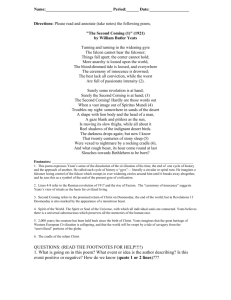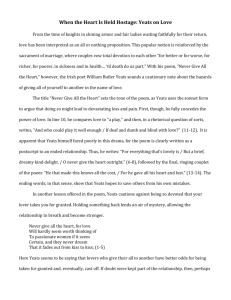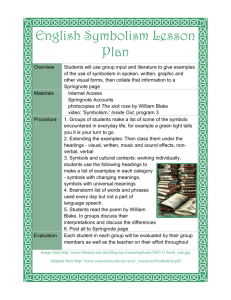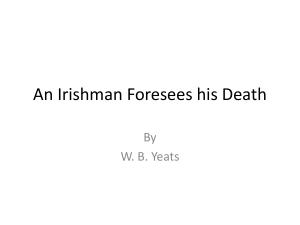The Allegory, Symbol and Myth
advertisement
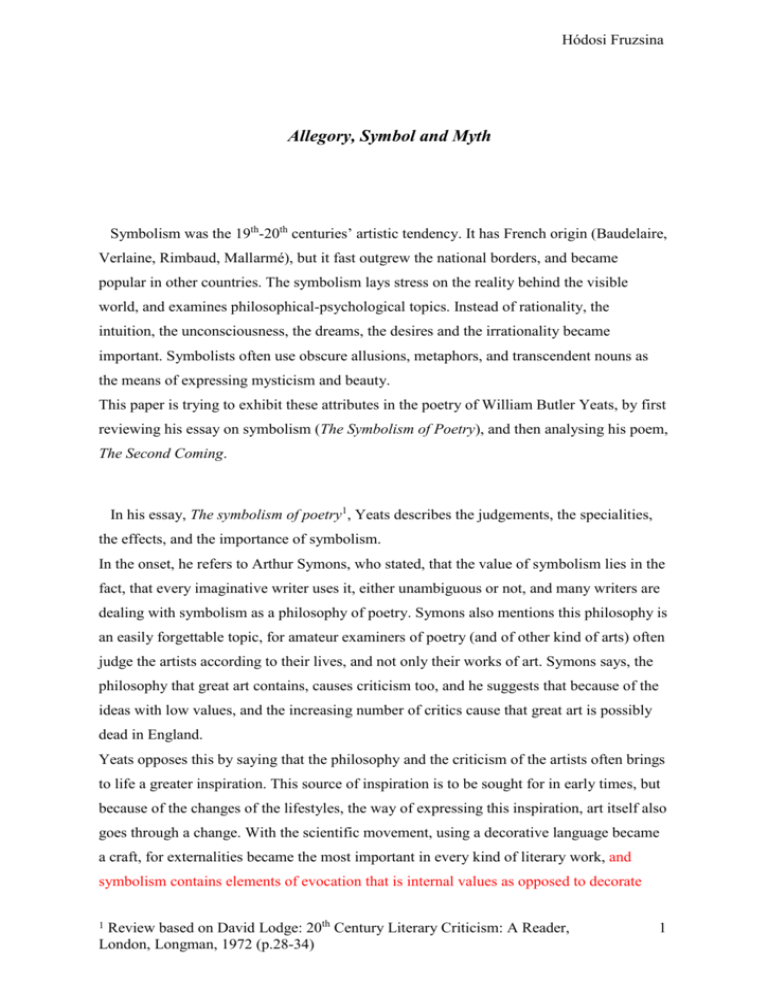
Hódosi Fruzsina Allegory, Symbol and Myth Symbolism was the 19th-20th centuries’ artistic tendency. It has French origin (Baudelaire, Verlaine, Rimbaud, Mallarmé), but it fast outgrew the national borders, and became popular in other countries. The symbolism lays stress on the reality behind the visible world, and examines philosophical-psychological topics. Instead of rationality, the intuition, the unconsciousness, the dreams, the desires and the irrationality became important. Symbolists often use obscure allusions, metaphors, and transcendent nouns as the means of expressing mysticism and beauty. This paper is trying to exhibit these attributes in the poetry of William Butler Yeats, by first reviewing his essay on symbolism (The Symbolism of Poetry), and then analysing his poem, The Second Coming. In his essay, The symbolism of poetry1, Yeats describes the judgements, the specialities, the effects, and the importance of symbolism. In the onset, he refers to Arthur Symons, who stated, that the value of symbolism lies in the fact, that every imaginative writer uses it, either unambiguous or not, and many writers are dealing with symbolism as a philosophy of poetry. Symons also mentions this philosophy is an easily forgettable topic, for amateur examiners of poetry (and of other kind of arts) often judge the artists according to their lives, and not only their works of art. Symons says, the philosophy that great art contains, causes criticism too, and he suggests that because of the ideas with low values, and the increasing number of critics cause that great art is possibly dead in England. Yeats opposes this by saying that the philosophy and the criticism of the artists often brings to life a greater inspiration. This source of inspiration is to be sought for in early times, but because of the changes of the lifestyles, the way of expressing this inspiration, art itself also goes through a change. With the scientific movement, using a decorative language became a craft, for externalities became the most important in every kind of literary work, and symbolism contains elements of evocation that is internal values as opposed to decorate Review based on David Lodge: 20th Century Literary Criticism: A Reader, London, Longman, 1972 (p.28-34) 1 1 language. With an example, Yeats shows how symbols, the most determining elements of symbolism work. He believes that symbols are the most perfect, complex and subtle images of poetry, and they cannot be replaced even by metaphors. The chains of events, the set of objects, the things of reality evoke emotions, and when they are in a musical relation, they unify, and evoke a more grandiose, new emotion or idea. The more they differ, the more powerful the emotion will be. Yeats reckons that the effect of emotions are temporary, though they are making and unmaking mankind, and so do the symbols, which are divine poetic forms of these emotions. After this, Yeats turns to the question of rhythm, as one of the poems determiners. The rhythm prolongs the moment of contemplation, at the border of consciousness and unconsciousness (or even beyond the frontier of consciousness), when we are both awake and asleep. It carries a monotony, which induces the same feeling as an ancient prayer or song, which allures us into a hypnotic trance, to a moment of creation. This also launches the subconscious, full of memories of a person’s life, desires and dreams. And because of this, making and understanding a work of art is easier in this kind of condition, when a poetic eye opens (the Inward Eye), and that’s why it is important to fill the poem with symbols and music. Besides the emotional symbols (that evoke emotions), there are also intellectual symbols, as Yeats mentions, which can suggest either ideas, or ideas mixed with emotions, and some critics and artist find only these latter ones real symbols. The responses and the emotions that the symbols call forth depend on the intellect. While the emotional symbols expand abstract thoughts, the intellectual ones develop a procession of symbols; and from the combination of the two kinds, a mingling with the procession is made up. These symbols can be understood and created through trance or meditation, when no other impulses from the reality can reach the reader and the author. Yeats states in the concluding part of his essay, that poetry moves the readers by its symbolism, because it provides a return to imagination. And this imagination can be only bound by the laws of art, and when people will accept this theory, it will bring about a change of style and substance. With this change, the rhythms will become perfect for meditation, and really become the embodiment of imagination. This change will put beauty to a central position, and the form will be able to express emotions the most rightful way. 2 And the form of sincere poetry, despite of its ungrammaticality and obscurity is going to have the perfection to yield new meanings every day, by its perfections and subtleties. Yeats’ poem, The Second Coming, was written in 1920, and thus the symbolic elements of this poem are creating a kind of mythological world, that is influenced by the happenings of the real world. As for the background of the poem, the First World War must be mentioned. The poem itself can be analysed from two main aspects, from the aspect of religion and from the aspect of war and anarchy. As for the first aspect, the religious kind of aspect, it must be stated, that Yeats was brought up in a Catholic way, and the poem shows the changing of his ideologies. In the line, ’The falcon cannot hear the falconer’ he describes that humanity has turned away from God. He suggests the ‘Second Coming’, and at the same time, he gets a vision from Spiritus Mundi, which can be interpreted either as the Holy Spirit, or as the ultimate god of paganists (it is a storehouse of images and symbols in Yeats’ philosophy). Both ways, the knowledge, he gets by this vision, in an unconscious state, is a divine one, and when he says ‘now I know’, it means that he is processing this knowledge. The vision shows him the prophecy of the future, which convinces him of the cyclic tendency of history (Bethlehem). The other thing he gets to know is that with God (‘the falconer’) the love and the respect of eternal goodness is fading away, and people are rather turning to the Spirit of World (‘Spiritus Mundi’; this is a positive motion for Yeats), and to the ultimate aim of the power. For this, Yeats ends the poem with his own prophecy, that the ‘Second Coming’ will be not Jesus’ rebirth, but rather the rebirth of the old religions, which come over Christianity, by offering a more realistic religion, which provides strength to all people, by the ‘Spiritus Mundi’, opposed to Christianity, because people are disappointed with its finiteness and weakness. In the final two lines, ’And what rough beast, its hour come round at last, Slouches towards Bethlehem to be born?’ Yeats expresses that the ‘beast’, and the ‘Second Coming’ do not allude to the rebirth of Jesus, but the embodiment of the hopeless power-lust and evil side of humanity that is 3 slowly getting control over the whole world. The Sphinx symbolizes paganism, which was overcome by Christianity two thousand years ago, and during that time, it has been getting power from the evil and negative sides of the people, and slowly rebuilding its kingdom’s foundation, and now it is ready to come to life again. And the Sphinx is the most perfect symbol for this, as it has the head of a man – symbolizing intelligence, the rational or reason, knowledge, and consciousness; and the body of a lion –representing the strength, the power to defeat anything and everything, and the animal side of the nature of man. Though this vision may be terrifying, it doesn’t mean the end of the world, just the beginning of a new, mythological kind of era. Thus, the Second Coming can also be (besides the negative possibility) a purification of the world of sin and evil, it can be described as the Last Judgement, or the Apocalypse, caused by mankind’s estrangement from God (again, as in the first line, ‘the falcon cannot hear the falconer’). And as for this, The Second Coming is very similar to Saint John’s Revelations. The origin of this mentality can be found both in Yeats’ interest in the Celtic culture or religion, and in his interest in the relationship between nature and history. These can be linked too, by the cyclical recurrence of all things (related to his gyres). The other aspect to analyse Yeats’ The Second Coming, is to have a look at the historical background of the poem. In 1920, the First World War has ended, but the shock it caused, remained. The senseless slaughter the war carried, when ration, and besides ration, the goodness was totally forgotten. Also, the status of that era’s Ireland can be added to this, for as the World War influenced the whole world’s mentality, so did the War of Independence influence the Irish mentality. Apart from the World War, Ireland at this time still fought for its freedom and independence. As the uprising on Easter Day, in 1916 was crushed, many innocent Irish were killed by the English army. And despite, in 1919, Ireland was proclaimed to be independent, an Irish government and army were established, the British government still didn’t approve them, and the War of Independence resumed unsuccessfully for many years. In this context, ‘the falcon cannot hear the falconer’ symbolizes that mankind became superficial, the inventions doesn’t serve any ideologies, they are becoming the means of the power. And they are used without thinking of the effects they cause, the details fade away, the origin, the way, the means don’t count anymore, the only important thing is the ultimate 4 power, the prey. ’Things fall apart’ he says, as the progression of humanity grown into a war, where rather the technology rules the man, than on the contrary. The utopias of the past ages, of the past generations became more irrational than ever. ’Mere anarchy is loosed upon the world, The blood-dimmed tide is loosed…’ The balance that existed for thousands of years, vanished. The instincts control the emotions and the rationality, the mankind became animalistic once more, the most evil side of humanity can be seen, and war cruelly claims many lives in the world. The events ran out of control, and couldn’t be stopped and the war is unleashed. This explains the pessimistic tone of the poem. ’The ceremony of innocence is drowned’ The war brings an anarchy of values. The ideologies are valueless; life is uncertain, and defenceless increases. In this context, The Second Coming is quite similar to Ady Endre’s Remembrance Of A Summer Night, and the other affinity between the two poems is that despite the losses, and the changing of the world, the poet still has hope, that this can be changed, and the prophecy is an open one, with the possibility to avoid it. With the loss of innocence, the human life’s rules are broken. And this innocence also means the soldiers who had to fight against a so-called enemy, had to put away their mentality, their ideologies, their thoughts (do they have the right to kill?), and that they are fighting against other human beings, with own passions, own feelings, own lives; for they were nothing more than the puppets of the power-maniacs ’The best lack all conviction, while the worst Are full of passionate intensity.’ These two lines are referring to the poet himself, and to those few other people, who dared to speak up against warfare. However, this protesting is passive, without the madness of fanatism. And despite of losing the conviction, the disappointment about human nature, and despite of the term, when weapons clash the muses are silent –it is still the obligation of the poet to raise his voice. This is also the end of describing the past; the next nine lines are describing the present that the poet faces with his vision, which is the most expressive part of the poem with its tough imagery. 5 The Spiritus Mundi, which gets the control over the poet, in this interpretation could refer to the collective subconscious, ad thus everyone would be able to summon this prophecy. However, war makes impossible for many people, to get in contact with their subconscious mind. In the second part of the poem, the visions of the desert, it is like a march, and the final hope –the possibility to find peace at last –is broken, by the deadly image of the desert. On the other hand this desert also puts the mind to some kind of ease, a state of meditation, near to death, or on the border of life and death, and at this trance-like moment, the eternal and indestructible image of the Sphinx appears, created in the past, existing in the present, and carrying the vision of the future. ’… while all about it, Reel shadows of the indignant desert birds’ With this image, the poem’s topic moves towards the future. The ‘bird’ as a symbol is not used in its traditional way, for representing freedom. Here, the birds are rather like the contrast of the ‘falcon’, or the opponents of the falcon; they are the guards of the Sphinx, watching out for the secret of the future, and trying to protect its mystery. And besides this, they also want to remove the intruder, who entered to their world, and disturbed it uninvitedly. And they in fact, succeed, for ’The darkness drops again…’ the poet, and the birds are still unsuccessful after all, because the poet could catch a glimpse of the future. In contrast with the slow motions of the great Sphinx, these birds are representing the dynamism, with their ‘indignance’ and ‘reeling’. In fact they are ‘desert birds’ to be more exact, and with an association, they could be even vultures –the nerve-racking, and stirring servants of a greater power, which could destroy them easily, and they are trying to obtain even the smallest pieces from the prey of this power. The great Sphinx, despite of its outrageous form, compared to them is like a great and majestic emperor. Returning to the present from the revelation, it comes to mind, that this great Sphinx, this embodiment of mankind’s wickedness, had been waiting for countless centuries to be reborn again. And during these centuries, it got the strength from the fears of Men, from the cruelty, the terror, and the hostilities, from the negative energies of the world. And all of these were fulfilled during the First World War, thus the Sphinx could embody again. After twenty centuries of waiting, it turned out finally, that human ideologies cannot exist 6 together peacefully, and the final evil should be born to sweep everything, and create a brand new era, at the same place, where Jesus was born. Yeats uses almost all means of symbolism in his poem. The main role of the symbols is evident from the analysis. He uses only this kind of figure of speech, because that’s what he prefers, rather than the less complex parallels and metaphors. The borderlines of the times –the past, the present and the future –are becoming effaced, as if the whole poem would happen at the same time (they coexist, the different dimensions of time). The mystical elements, as symbols, are making the intelligibility of the poem tougher, but they are aso making it more individual. As an individual specialty, it can be marked that Yeats doesn’t use these mystical symbols as other symbolists would do: with capital letters. Only the originally transcendent symbols –Second Coming, Spiritus Mundi –are written in this form, the non-spiritual symbols are not stressed (falcon, falconer, beast). The contrasts, like living and dead, abstract and real, objective and subjective tone bring dynamism to the poem, as a replacements of the dynamic verbs. Yeats with his system of symbols created an own mythology, that serves as a tool with which the reader can sense reality. The words are conveying new meanings that are far beyond their original function. This symbolic system is created arbitrarily, and as a result of an analogical thinking. That’s why the symbols are original and individual, but at the same time obscure, too. Yeats, as a symbolist, believed that this obscurity can create a lyrical feeling by itself. Your analysis of Yeats’ poem is indeed very thorough and subtle reflecting an almost poetic kind of sensibility and an insight into the historical, psychological as well as into the spiritual and symbolical implications of the work. Perhaps due to the emotional tone of your essay, the language of your writing at some places is closer to spoken language than an academic one, even if your thoughts and idees behind it are of a serious and elevated nature. Your analysis contains very subtle observations concerning human nature and history. Well done. 7
